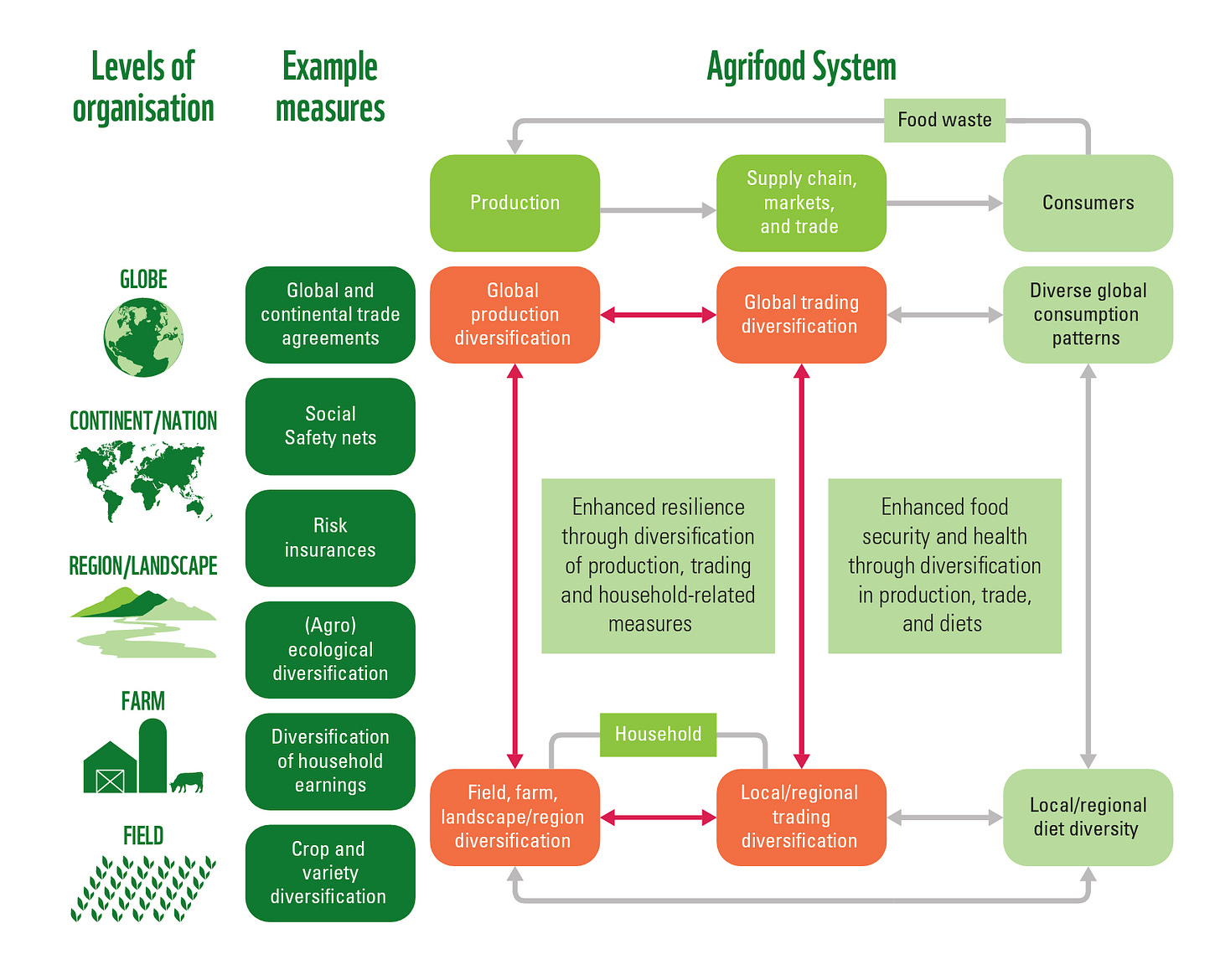21 October 2022. Biodiversity, again | Politics
Ways to salvage the biodiversity crisis // Laughing at Britain’s 45 day Prime Minister
Welcome to Just Two Things, which I try to publish three days a week. Some links may also appear on my blog from time to time. Links to the main articles are in cross-heads as well as the story. A reminder that if you don’t see Just Two Things in your inbox, it might have been routed to your spam filter. Comments are open. Have a good weekend
1: Ways to salvage the biodiversity crisis
I wrote here earlier this week about the 2022 edition of the Living Planet Report, written by the World Wildlife Fund and published by the WWF and the London Zoological Society. In that piece, I basically focussed on the bad news. Biodiversity is in decline and we need to act rapidly, in the current decade, if it is not to become a century-long crisis (or possibly even irreversible).
But the report isn’t completely miserable. It does have some ideas about what we can do. I’m going to discuss these here today.
One of the first observations is about the need to learn from indigenous peoples, who have generally been better at protecting habitats than the rest of us. This is an increasing theme in the biodiversity literature, and the report has a catchy image about it:
(Image: The Living Planet Report 2022. Illustration commissioned from Nicole Marie Burton.)
In the diagram, the relationships between traditional ecological knowledge, Indigenous science and Indigenous knowledge systems are shown through the lens of the life cycle of the Pacific salmon:
The understandings and philosophies embedded with this centre are carried through time and across generations, through language, story, ceremony, practice and law. Salmon and Salmon People not only coexist in these settings but are interdependent on one another.
Indeed, one of the most resonant passages in Robin Wall Kimmerer’s book Braiding Sweetgrass is about the way in which the native Americans of the Pacific coast used to husband their salmon, understanding their full beneficial impact.
This section of the report introduced a new word to me—Etuaptmumk, or “two eyed seeing”, which means seeing through one eye with indigenous knowledge and ways of knowing, and through the other with mainstream knowledge and ways of knowing:
Etuaptmumk, when practised and honoured appropriately, means not only working with Indigenous knowledge as another source of evidence, but also the people and the land inherently tied to these ways of knowing.
As long as you don’t end up cross-eyed, I guess.
(Smikra Wahikwa, ‘The future is ancestral’. Sonia Guajajara, Celia Xakriaba, and the Earth Collective. Barbican, Our Time on Earth, 2022. Photo, Andrew Curry: CC BY-NC-SA 4.0)
The second theme in the report is about the value of rights in promoting the protection of diversity. An article by David Boyd, the UN Special Rapporteur on human rights and the environment, describes
a vision of a world where everyone’s fundamental human right to live in a clean, healthy and sustainable environment is respected by governments and businesses.
During the course of 2022, the United Nations General Assembly recognised that this was a universal right. This follows action by a number of countries over two decades to recognise such rights in law. Boyd argues that recognition of this right is already making a difference in protecting biodiversity:
In recent months, the right to a healthy environment has been used by communities to block offshore oil and gas activities in Argentina and South Africa, because of the potential impacts on marine mammals. The right was used to compel governments in Indonesia and South Africa to take action to improve air quality and to stop an ill-advised coal-fired power project in Kenya. The right was used to protect forests from mining in Ecuador and to eliminate the use of a bee-killing pesticide in Costa Rica. Climate lawsuits drawing upon the right to a healthy environment are occurring all over the world.
But the most important thing to do is to take action to reverse the significant drivers of change that cause the loss of biodiversity. The report notes that these are interconnected, of course. One of these drivers is the existing global trade model:
The intricate web of supply chains underlying our economies means that these negative trade-related impacts on nature and people can be shifted around the world, from buyers to sellers and exporters to importers. Therefore, the phenomenon of exported biodiversity risk through international supply chains, such as exported deforestation, is a critically important driver of biodiversity loss that must be addressed.
The report references the work of TRADE Hub in identifying the impacts and issues, and trying to disentangle them.
World food production is also a significant factor in biodiversity loss—the largest, in fact.
Diversification in food production, particularly across cropping and animal systems, is a means of increasing productivity, building resilience to climate change, enhancing resistance to pests and diseases, buffering economic shocks, improving the ecological performance of crops, and conserving biodiversity.
Obviously this is complex, but the report has a helpful diagram on how it might work in practice.
(Source: Living Planet Report, 2022.)
The third approach is a better understanding of the systems at play, so that proposals for transformation create “co-benefits” rather than trade-offs in which some of the Sustainable Development Goals are enhanced at the expense of others. Some of this can be done by modelling that identifies pathways that create such mutual benefits between multiple objectives:
(W)hile technically challenging... this will support a needed shift in governance and policy towards integrated thinking and nexus approaches. This concept needs to cover also indirect, and sometimes long-distance, inter-relationships; for example in global supply chains, and the broader sustainable development agenda, including other environmental and social issues such as freshwater use, pollution, poverty and hunger.
There are examples in the report of how this works in practice in Zambia, and also some brief explanations of the modelling processes involved.
The fourth issue is about economics. The report proposes three critical changes that are needed to make economics work for the planet rather than against it:
The prices of commodities and inputs should reflect the true cost to society in terms of environmental and human impacts
The use of economic tools like social cost-benefit analysis, and improved discounting to account for very long-term horizons, should become part of the global standard of practice for credible decision-making by businesses, financial institutions, and multilateral organisations
An improved recognition of the public nature of key natural resources (e.g. our oceans, rivers and riparian forests, wetlands) should lead to special attention in terms of governance and precautionary safeguards.
The last one of these needs to start with the Amazon, says the report. We should protect 80% of it by 2025. There’s a better chance of that happening if Lula wins the Brazilian run-off election in a week’s time. But it also speaks to an economic issue that isn’t covered in the report, as far as I can see.
This is that the incentives for destroying biodiversity, for those commercial actors who don’t have scruples about doing it, are far richer that than incentives for leaving it intact. There are business models out there that seek to reverse this, but—as with other environmental issues—they are not scaling fast enough.
(Vision of the Living and Sustainable Amazon. Source: Science Panel for the Amazon (2021). Via the Living Planet Report 2022).
2: Laughing at Britain’s 45 day Prime Minister
I was going to write something serious here today, and I have a general rule on Just Two Things about not treading on the private grief that is local British politics. But when a Prime Minister resigns after a record-breakingly short spell in office,1 and the public reaction sits on a scale between hilarity and grief, I probably need to break that rule.
It’s the end of the week, and as a public service I’m just going to point to some of the better jokes and memes.
I don’t like giving publicity to Ryanair, but their social media team was quick off the mark, as the Irish magazine Evoke noted in a piece on Liz Truss memes:
In one of the replies to that tweet, someone had tested the QR ticket on the ticket:
Evoke’s column also mentioned the lettuce on which the British “newspaper” the Daily Star had trained a live webcam a week ago, asking whether it would outlast Truss.
(Source: The Daily Star)
In the meantime the lettuce has become something of a global celebrity. In fact, USA Today devoted a column to explaining to its readers the link between the lettuce and Liz Truss. The Irish comedian Paddy Raff had a lettuce themed gag on twitter after she resigned, although by this time the plot had probably jumped the shark:
My own WhatsApp feeds have had a couple of good images in them, that also reflect the general British mood.
Truss had abruptly fired her first Chancellor of the Exchequer Kwasi Kwarteng less than a week ago, in an attempt to save her Premiership, and appointed a new one, Jeremy Hunt, probably through gritted teeth. On the subject of Chancellors (the name for the British finance minister), the Irish poet Ian Duhig posted some prescient lines a few days ago:

But I should probably leave this piece with an image from the satirist Cold War Steve, who has had a great few days.
The man on the phone at the back is the former England manager Sam Allardyce, who lasted for 67 days as England manager a few years ago. Of course, the figures on the tumbril are the last four Conservative Prime Ministers. The cart driver is Graham Brady, of the Conservative 1922 Committee, to whom backbench Conservative MPs send their letters of no-confidence in sitting Prime Ministers.
The deeper truth here is that the Conservative party is in a long term decline that seems suddenly to have accelerated. There will be more thoughtful pieces in the days to come, but I did write a long piece about this here a few weeks ago. There’s a version on my blog if you don’t just want to do jokes today.
j2t#384
If you are enjoying Just Two Things, please do send it on to a friend or colleague.
The previous record holder, George Canning, lasted 119 days in office until he died of tuberculosis.



















